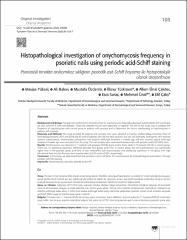| dc.contributor.author | Yüksel, Mavişe | |
| dc.contributor.author | Balevi, Ali | |
| dc.contributor.author | Özdemir, Mustafa | |
| dc.contributor.author | Türkmen, İlknur | |
| dc.contributor.author | Çakıter, Alkım Ünal | |
| dc.contributor.author | Saraç, Esra | |
| dc.contributor.author | Ünal, Mehmet | |
| dc.contributor.author | Çalış, Elif | |
| dc.date.accessioned | 2020-11-05T07:07:04Z | |
| dc.date.available | 2020-11-05T07:07:04Z | |
| dc.date.issued | 2020 | en_US |
| dc.identifier.citation | Yüksel, M., Balevi, A., Özdemir, M., Türkmen, İ., Çakıter, A. Ü., Saraç, E. ... Çalış, E. (2020). Histopathological investigation of onychomycosis frequency in psoriatic nails using periodic acid-schiff staining. Turkderm-Turkish Archives of Dermatology and Venereology, 54(3), 103-107. https://dx.doi.org/10.4274/turkderm.galenos.2020.23090 | en_US |
| dc.identifier.issn | 2717-6398 | |
| dc.identifier.issn | 2651-5164 | |
| dc.identifier.uri | https://dx.doi.org/10.4274/turkderm.galenos.2020.23090 | |
| dc.identifier.uri | https://hdl.handle.net/20.500.12511/5998 | |
| dc.description.abstract | Background and Design: Psoriasis nail involvement is clinically similar to onychomycosis. Especially subungual hyperkeratosis and onycholysis are also common in both nail diseases. These two diseases may be seen separetely or together. The aim of this study was to compare the frequency of onychomycosis with control group in patients with psoriasis and to determine the factors predisposing to onychomycosis in patients with psoriasis.Materials and Methods: The study included 43 patients with psoriasis who were admitted to Istanbul Medipol Mega University, Clinic of Dermatology between 2017 and 2018 and 43 control patients who did not have psoriasis and had nail dystrophy. Participants who received systemic corticosteroid, methotrexate, cyclosporine, and systemic antifungal treatment 4 months ago and who received topical antifungal treatment 4 weeks ago were excluded from the study. The nail samples were examined histochemically with periodic acid-Schiff (PAS) stain.Results: Onychomycosis was detected in 11 patients with psoriasis (25.6%) (hand and/or foot), while in 17 patients (39.5%) in control group. There was no statistically significant difference between two groups (p=0.170). In control group, toe nail onychomycosis was significantly higher than in the psoriatic group (p=0.024). It was noteworthy that onychomycosis was statistically significant in the group with high educational level and low Psoriasis Area Severity Index (p<0.05 and p=0.021, respectively).Conclusion: In this study, we determined that nail psoriasis is not a risk factor for onychomycosis by histopathological examination of fungal samples with PAS staining. | en_US |
| dc.language.iso | eng | en_US |
| dc.publisher | Deri ve Zührevi Hastalıklar Derneği | en_US |
| dc.rights | info:eu-repo/semantics/openAccess | en_US |
| dc.subject | Onychomycosis | en_US |
| dc.subject | Psoriasis | en_US |
| dc.subject | Periodic Acid-Schiff | en_US |
| dc.title | Histopathological investigation of onychomycosis frequency in psoriatic nails using periodic acid-schiff staining | en_US |
| dc.type | article | en_US |
| dc.relation.ispartof | Turkderm-Turkish Archives of Dermatology and Venereology | en_US |
| dc.department | İstanbul Medipol Üniversitesi, Tıp Fakültesi, Dahili Tıp Bilimleri Bölümü, Deri ve Zührevi Hastalıklar Ana Bilim Dalı | en_US |
| dc.department | İstanbul Medipol Üniversitesi, Tıp Fakültesi, Cerrahi Tıp Bilimleri Bölümü, Tıbbi Patoloji Ana Bilim Dalı | en_US |
| dc.authorid | 0000-0002-0011-7570 | en_US |
| dc.authorid | 0000-0001-5057-0405 | en_US |
| dc.authorid | 0000-0002-7022-913X | en_US |
| dc.authorid | 0000-0002-4119-9939 | en_US |
| dc.authorid | 0000-0002-9870-9733 | en_US |
| dc.authorid | 0000-0002-0600-5801 | en_US |
| dc.identifier.volume | 54 | en_US |
| dc.identifier.issue | 3 | en_US |
| dc.identifier.startpage | 103 | en_US |
| dc.identifier.endpage | 107 | en_US |
| dc.relation.publicationcategory | Makale - Uluslararası Hakemli Dergi - Kurum Öğretim Elemanı | en_US |
| dc.identifier.doi | 10.4274/turkderm.galenos.2020.23090 | en_US |
| dc.identifier.scopusquality | Q4 | en_US |


















